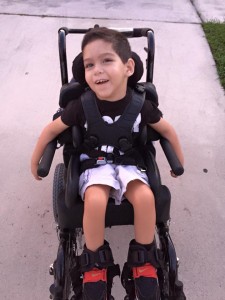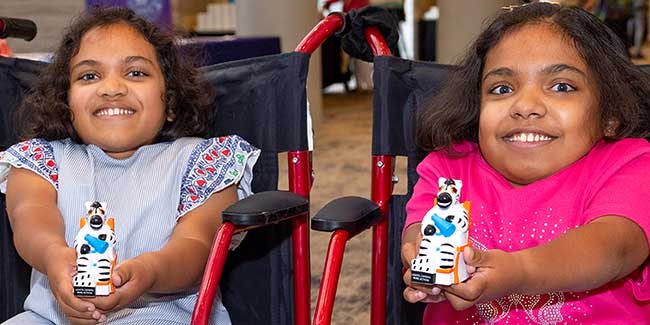On July 27, 2011 the Cruz family welcomed a gorgeous baby boy, Liam, to their lives. Weighing 7lbs and 19 inches long, he was born at Greenwich Hospital in Greenwich, CT and discharged with a clean bill of health.
At the age of 6 months, the family began to notice that Liam was not reaching his developmental milestones, such as holding his head up properly, rolling over from his belly on to his back, sitting up on his own and bringing his hands to his mouth. Liam’s appetite was very poor as well. At best, they noticed that he was only finishing half of his feedings at a time. It was then that they brought their concerns to Liam’s pediatrician whom suggested that Liam be evaluated with an Early Childhood Intervention Specialist, as well as conduct a battery of tests to determine if something was off neurologically, metabolically, etc.
 Several tests were conducted to determine the cause of Liam’s developmental delays, from numerous blood tests, to sleep studies, to MRI’s of the brain. However, none provided any leads on what was causing Liam’s delays with achieving his milestones, with the exception of determining that he had tracheomalacia and hypotonia. These were both side effects from the root cause of his condition, which was yet to be identified. At this time, Liam was constantly in and out of the hospital due to croup, bronchitis or what seemed to be seizures in his sleep. To no avail, the Cruz’s still did not receive a proper diagnosis, which inhibited them from providing the appropriate care, services and medical coverage for their son.
Several tests were conducted to determine the cause of Liam’s developmental delays, from numerous blood tests, to sleep studies, to MRI’s of the brain. However, none provided any leads on what was causing Liam’s delays with achieving his milestones, with the exception of determining that he had tracheomalacia and hypotonia. These were both side effects from the root cause of his condition, which was yet to be identified. At this time, Liam was constantly in and out of the hospital due to croup, bronchitis or what seemed to be seizures in his sleep. To no avail, the Cruz’s still did not receive a proper diagnosis, which inhibited them from providing the appropriate care, services and medical coverage for their son.
In 2013, relentless in their pursuit to obtain a proper diagnosis for Liam, they made countless calls to Columbia Presbyterian to have him seen by Chief of Pediatric Neurology, Dr. Chiriboga. It was then that Dr. Chiriboga diagnosed Liam with cerebral palsy, with mixed spasticity, and determined that therapy and proper treatment were needed immediately. Dr. Chiriboga further explained to them that genetic blood testing should be conducted on Liam, and both his mother and father to help determine the root cause of Liam’s condition or any other conditions that could potentially surface later on. Going off of this recommendation, the blood work was taken in order to be sent out for testing. Several weeks later the family received approval from Medicaid for the tests, only to be denied a few months later, when they had received a letter explaining that the genetic blood tests would not be covered. The expense, which exceeded $10,000, would have to be paid by them out-of-pocket. At this point in time, Medicaid was their only insurance as both of Liam’s parents lost their jobs shortly after receiving Liam’s diagnosis. With no supplemental health insurance, they were at the mercy of Medicaid to cover Liam’s medical bills. Needless to say, their quest to obtain a root cause for Liam’s condition came to a screeching halt.
Over the next several months, Liam was constantly in and out of the hospital with breathing issues, as he would wake up multiple times each night gasping for air and choking. It was then when Liam was diagnosed with “respiratory disease” and “failure to thrive” which was deemed as severe and critical. Concurrent to this, Liam’s drastic weight loss concerned his gastroenterologist. He strongly suggested inserting a G-Tube through Liam’s belly to administer daily routine feedings to regain his weight, which was critical to Liam’s development. On June 6, 2014 Liam underwent surgery to have a G-Tube inserted into his belly. After the surgery, Liam’s oxygen levels dropped dramatically and the hospital staff called a “code red” to have all hands on deck to tend to Liam and get his oxygen levels back to a stable state. The following day, Liam’s G-Tube popped out and he was rushed to emergency surgery to re-insert the G-Tube. This was an extremely stressful and trying time for the entire family, and an unbearable one for Liam. Adjusting to a routine of administering daily feedings via a pump/tube also proved to be very challenging and stressful, as everything they did needed to revolve around this new feeding system. It was imperative for Liam to regain his weight and reach an adequate one before he could be taken off his G-Tube. To this day, Liam remains with his G-Tube, as he cannot swallow whole foods without choking, aspirating and/or vomiting.
In January 2015, the family decided to move to Florida as Liam’s doctors suggested that warmer weather climate areas would be better for a child with his diagnosis and condition. Because the Cruz’s were living in a 6-story building in New York with limited access to an elevator, the move would also prove to be easier on Liam’s parents. Many times they needed to carry Liam up and down five flights of stairs with his wheelchair. There were times when Liam’s school bus would leave without him because it took them several minutes to get him down the stairs. So the family was uprooted and moved to South Florida where Liam’s mother was raised. In Florida, they had to restart the process of obtaining State Medicaid for Liam, as there are no transfers from state to state. They were informed that the process takes approximately two years for approval, so Liam would be without proper care and necessary services. In addition, they had to find new physicians and specialists to assist with Liam’s development and to provide guidance on how to care for him.

The family felt fortunate to find Joe DiMaggio Children’s Hospital where they were able to obtain a gastroenterologist, a pulmonologist, physiatrist, geneticist, neurologist, orthopedic, and an endocrinologist, all which are needed to treat Liam’s condition. At this hospital, Liam’s specialists were able to obtain his medical records from Columbia Presbyterian in NY, where they had found genetic test results from the blood tests that were taken two years prior. The same tests that were not approved by Medicaid had been conducted and the Cruz family was not aware. These tests contained the diagnosis that they had long been looking for.
The physicians at Joe DiMaggio Children’s Hospital shared these results with them and explained that Liam has Allan-Herndon-Dudley syndrome (AHDS). This syndrome is a rare X-linked inherited disorder of brain development that causes moderate to severe intellectual disability and problems with movement. This condition, which occurs almost exclusively in males, disrupts development from before birth. Most children with AHDS have weak muscle tone (hypotonia) and underdevelopment of many muscles (muscle hypoplasia). As they get older, they usually develop joint deformities called contractures, which restrict the movement of certain joints. Abnormal muscle stiffness (spasticity), muscle weakness, and involuntary movements of the arms and legs also limit mobility. As a result, many people with AHDS are unable to walk independently and become wheelchair-bound by adulthood.
Crushed with the news and discovery of this rare disease/disorder, which had unrightfully eluded the Cruz’s for four long years, the family had to devise a new road map to care of their son. There are only 80 recorded cases worldwide of children with AHDS. This disorder is so rare that there is no known treatment or cure, other than constant physical, occupational, and speech therapy. It is so rare that many services, equipment needs and medical bills are denied, as insurance companies do not recognize this disorder.

Liam’s father, Will, stated, “Liam’s future is still unclear to us; however, his unwavering spirit and loving personality is what keeps us driven to find a cure or treatment.” He explained that many who have had the opportunity to meet or work with Liam love him. He greets everyone with a warm smile and offers a hug and or a kiss to let you know that you have a friend in him forever. He never complains when it’s time for physical or occupational therapy; he actually enjoys it and puts in the hard work with each session. It’s Liam’s determination to get better and stronger with each passing day that keeps the Cruz family pressing forward!





